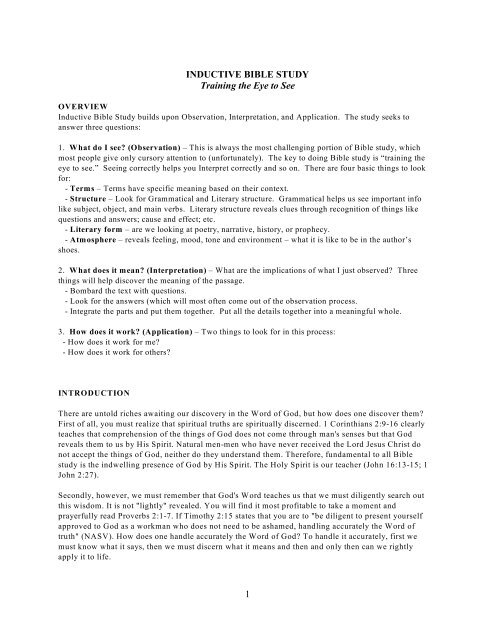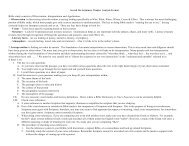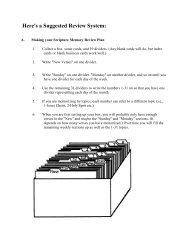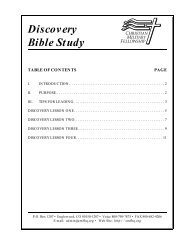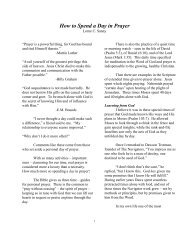Inductive Bible Study Training The Eye To See
Inductive Bible Study Training The Eye To See
Inductive Bible Study Training The Eye To See
Create successful ePaper yourself
Turn your PDF publications into a flip-book with our unique Google optimized e-Paper software.
INDUCTIVE BIBLE STUDY<strong>Training</strong> the <strong>Eye</strong> to <strong>See</strong>OVERVIEW<strong>Inductive</strong> <strong>Bible</strong> <strong>Study</strong> builds upon Observation, Interpretation, and Application. <strong>The</strong> study seeks toanswer three questions:1. What do I see? (Observation) – This is always the most challenging portion of <strong>Bible</strong> study, whichmost people give only cursory attention to (unfortunately). <strong>The</strong> key to doing <strong>Bible</strong> study is “training theeye to see.” <strong>See</strong>ing correctly helps you Interpret correctly and so on. <strong>The</strong>re are four basic things to lookfor:- Terms – Terms have specific meaning based on their context.- Structure – Look for Grammatical and Literary structure. Grammatical helps us see important infolike subject, object, and main verbs. Literary structure reveals clues through recognition of things likequestions and answers; cause and effect; etc.- Literary form – are we looking at poetry, narrative, history, or prophecy.- Atmosphere – reveals feeling, mood, tone and environment – what it is like to be in the author’sshoes.2. What does it mean? (Interpretation) – What are the implications of what I just observed? Threethings will help discover the meaning of the passage.- Bombard the text with questions.- Look for the answers (which will most often come out of the observation process.- Integrate the parts and put them together. Put all the details together into a meaningful whole.3. How does it work? (Application) – Two things to look for in this process:- How does it work for me?- How does it work for others?INTRODUCTION<strong>The</strong>re are untold riches awaiting our discovery in the Word of God, but how does one discover them?First of all, you must realize that spiritual truths are spiritually discerned. 1 Corinthians 2:9-16 clearlyteaches that comprehension of the things of God does not come through man's senses but that Godreveals them to us by His Spirit. Natural men-men who have never received the Lord Jesus Christ donot accept the things of God, neither do they understand them. <strong>The</strong>refore, fundamental to all <strong>Bible</strong>study is the indwelling presence of God by His Spirit. <strong>The</strong> Holy Spirit is our teacher (John 16:13-15; 1John 2:27).Secondly, however, we must remember that God's Word teaches us that we must diligently search outthis wisdom. It is not "lightly" revealed. You will find it most profitable to take a moment andprayerfully read Proverbs 2:1-7. If Timothy 2:15 states that you are to "be diligent to present yourselfapproved to God as a workman who does not need to be ashamed, handling accurately the Word oftruth" (NASV). How does one handle accurately the Word of God? <strong>To</strong> handle it accurately, first wemust know what it says, then we must discern what it means and then and only then can we rightlyapply it to life.1
<strong>The</strong> systematic inductive approach to the study of God's Word is the most profitable. Our method isbasically an inductive one. <strong>Inductive</strong> <strong>Bible</strong> study begins with a study of the Word of God itself, ratherthan books or commentaries about the <strong>Bible</strong>.OUR APPROACH IN STUDYING A BOOK IS:1. <strong>To</strong> become acquainted with the book through observation2. <strong>To</strong> get an overview of the book by constructing a Horizontal Book Chart (this can be done in aSimple form or a Detailed form). We call this Charting.3. <strong>To</strong> discover the setting and occasion of the book (included in the Charting format provided)4. <strong>To</strong> do an Observation Worksheet on each chapter or sub-chapter.5. <strong>To</strong> do accurate Interpretation of what the author is saying6. <strong>To</strong> make personal Application<strong>To</strong> glean the riches of God's truth requires uninterrupted study time. You must commit yourself to bediligent and steadfast in your study.PROCEDURE FOR COMPLETING THE OVERVIEWI. Ask God, by His Spirit, to lead you into all truth, to open your eyes that you may beholdwondrous things out of His Word.II. Read and re-read the book to be studied. <strong>The</strong> more you read the book, the better you will knowthe book. As you read, keep asking the Holy Spirit to give you "the spirit of wisdom andrevelation in the knowledge of Him." <strong>The</strong>re is no substitute for reading and prayerfully meditatingon the Word of God. A good idea here is to read the book in multiple translations.III. On your first reading of the book:A. Read it in one sitting without stopping to analyze the book.B. When you finish, make notes of your first impressions of the book.III.As you repeatedly read through the book, train your eyes to look for the following:A. Repetition of key words and phrases1. A key word is an important or essential word in the text. It might be a noun, a descriptiveword or an action word that plays a key part in conveying what the author wants to say.2. Examples of some key words in 1 John (based on KJV) are:a. "Know": used 28 times and evenly distributed throughout the book.b. "Sin": used 28 times throughout the book, but heaviest concentration is in chapterthree.c. "Love": used 46 times, 27 of which are found in chapter four.4. Examples of some key phrases in 1 John.a. "Born of him" or the synonymous term "begotten of him" is used 9 times in the book, 5of which are found in chapter five.b. "Write unto you" is used approximately 12 times.2
C. Contrasting words and phrases1. Much truth can be illustrated by contrast, showing opposites, or differences. When you see acontrast, note the characteristics, if any, used to describe the things contrasted.2. Examples of 1 John (KJV)a. Darkness/light-1 John 1:5-7b. Children of God/children of the devil-1 John 3:10c. Love/hate-1 John 2:9-10D. Lists of words, phrases, or related thoughts1. Lists are series of things. A list might be contained within one verse, several verses, orspread throughout a paragraph, chapter, or book.2. Examples from 1 John (KJV)a. "Lusts of the flesh, lust of the eyes, and the pride of life." 1 John 2:16b. A broad list would be to take the repeated phrase, "born of God" or "begotten of him"from 1 John 5 and list the characteristics of one born of God as shown in the fifthchapter.C. Changes in subject or thought1. <strong>The</strong> <strong>Bible</strong> is not just a compilation of "verses" which are totally independent of one another,totally unrelated. Verses are manmade divisions of God's Word. God's Word is anexpression of truth—truth of a broad number of subjects. <strong>The</strong>refore, it is important for us tonote the relationship of one verse to another, or to note when the thought or subject changes.2. An example of change in thought or subject in 1 John.a. In chapter one, John deals with fellowship, mentioning the word four times-but neverusing it again throughout the book. In 1:8-2:2 he changes the subject and talks about sin(note sin is used 8 times in 5 verses).b. In a short book, the changes in subject may not be as distinct or as many as in a booklike I Corinthians where Paul deals with many subjects.C. Terms of conclusion such as "wherefore"; "therefore"; or "finally"1. <strong>The</strong>re is a saying—"find out what the therefore is there for."2. An example of terms of conclusion is found in 1 Cor. 15:58. Why does Paul tell us"therefore, be steadfast, immovable" at the end of this chapter on the resurrection?C. Words of comparison, such as "like", "as," or "as it were"1. Terms of comparison are used to point out similarities or likenesses and many times amplifyour understanding or comprehension of a thing, person or place.2. Sometimes it will show you not only the comparison, but the way it is similar. Note Matt.24:38, "as in those days (comparison) ... they were eating and drinking, they were marryingand giving in marriage." This verse not only gives the comparison but also shows how theycompare, what the similarities are.3. Examples of terms of comparison3
a. <strong>The</strong> book of Revelation has many such terms—note Rev. 9:3. . . "as the scorpions onearth have power."b. Look at Rev. 4:3—"he... was like a jasper stone." It is showing a similarity rather thansaying Christ is a jasper stone.IV.As you read, train your mind to ask the "Five W's and an H."A. WHO: wrote it? to whom? about whom? to whom is he speaking?B. WHAT: are the main events? are the major ideas? are the major doctrines? is he talkingabout? is his purpose in saying that?C. WHEN: was it written? did this event take place? will it happen? did he say it?D. WHERE: was this done? was this said? will it happen?E. WHY: was this written? was this mentioned? was it not mentioned? was so much or 'so littlespace devoted to this particular event or teaching? this reference?F. HOW: is it done? well? is this truth illustrated?HOW TO DO A HORIZONTAL BOOK CHARTPURPOSEIt is absolutely essential that you get the overview of a book before you begin to analyze it chapter bychapter so that you can see the relationship of the parts to the whole. This is accomplished through aHorizontal Book Chart (called Charting). <strong>The</strong>refore, doing a Horizontal Book Chart will serve twopurposes. First, it will give you an overview of the book as a whole. <strong>The</strong> overview is obtained by titlingeach chapter of the book in such a way that the title summarizes the main teaching of each chapter.Secondly, a Horizontal Book Chart will help you analyze the structure of the book you are studying.(<strong>See</strong> sample charts on the CMF <strong>Training</strong> <strong>Bible</strong> <strong>Study</strong> web page under "Further <strong>Study</strong>".)STRUCTURE: <strong>The</strong> structure of the book is discerned by seeing the different divisions of the book.<strong>The</strong>se divisions are called segment divisions and will show you how the author lays out his writing.SEGMENT DIVISIONS: Segment divisions will require time and practice. Usually, you will see ageneral or broad division of a book after doing the overview. For instance, in Romans, chapters 1-11 aredoctrinal; chapters 12-16 are practical. This is a segment division. You will find yourself discoveringmore possible segment divisions of a book after you have studied the book for awhile. So then, thesegment division part of your Horizontal Book Chart will be developed more freely as you become morefamiliar with a book. Segment divisions will frequently but not always fall between chapters in a book.V. After you have read the book several times, write out the answers to following questions:A. Who is the author of this book? Many times to understand a book, you need to understand thebackground of the one who wrote the book. At what period of his life was the book written?What were the circumstances in his life when he undertook his writing? Finding the answers tothese questions many times will shed a whole new light on your understanding of a book, ormay even make the difference between correct and incorrect interpretation. How do you findthe answers to these questions and how do you determine their value in understanding a book?<strong>The</strong> best place to find out who wrote the book is a <strong>Bible</strong> Handbook or <strong>Bible</strong> Dictionary.B. <strong>To</strong> whom was this book written (audience)? <strong>The</strong> best place to find out who wrote the book isalso a <strong>Bible</strong> Handbook or <strong>Bible</strong> Dictionary4
C. What is the historical setting surrounding the writing of the book and/or events in occurring inthe book? As you do the preliminary reading of the book you are studying, record in yournotebook any references to geographical locations, historical events, persons, or customs. <strong>The</strong>sewill give you clues to the historical setting of the book. If historical events are mentioned, thiswill give you a clue as to when the book was written unless it is a prophetical book. <strong>The</strong> date ofwriting is usually discussed in your commentaries in the introduction to the book. Otherwise,historical events will usually be studied as you do interpretation.D. What type of literature is it? It might be one of the following or a combination:1. Historical—e.g. Acts2. Biographical—e.g. Luke3. Poetical—e.g. Psalms4. Prophetical—e.g. Revelation5. Philosophical—e.g. Proverbs6. Letter—e.g. II TimothyE. What is the overall purpose of the book, from what you can observe thus far?F. What is the style or atmosphere of the book? Atmosphere is the feeling the author producesthrough his words or the recording of certain events. <strong>The</strong> atmosphere may be one of love, hate,joy, expectancy, peace, turmoil, distress, etc.G. What key words are repeated in the book?H. What is the main theme or themes of the book?I. Are there any other additional noteworthy personalities in addition to the author and theyaudience?J. Is there any relevant geography associate with the book? If geographical locations arementioned, then turn to the back of your <strong>Bible</strong> and look up these places on a map.One final word before we begin Charting. <strong>See</strong>ing how the parts of the whole book relate to one anotheris vital to your understanding of individual verses within the book, as well as to the overall meaning. Notseeing the proper relationship of the parts to the whole is many times what causes perverted or wrongdoctrine. Remember Scripture cannot contradict itself.Now then, let's begin ... step by step. How excited you'll be at all you are going to learn as you patientlydevelop these new skills!PROCEDUREI. OverviewA. Use a scrap piece of paper and organize it as shown for either Simple Charting or DetailedCharting.Example of Simple ChartingDIVISION TITLE5
Example of Detailed ChartingTITLE DIVISION DESCRIPTIONB. Read through the book looking for natural divisions or breaks in thought in what is written.Frequently, these will occur at chapter divisions, but not always. As you read each chapter,look for repeated words and phrases that would give you a general idea of its main orpredominant theme for each division.C. For Simple Charting, develop a Title for each division based upon the content within eachdivision (see the 2 <strong>The</strong>s charting example to see Simple Charting). Use these simple rules fortitling:1. Make title short but descriptive.2. A title should contain at least one key word from the division, if possible. It is better to usewords from the text rather than a paraphrase.3. A title should be distinctive from all other division titles.A. If you desire to do Detailed Charting, write down a description of what is discussion withineach division (see the 1 John charting example to see Detailed Charting).B. When you finish writing down the description in your own words, then take each divisiondescription and title it according to the rules above. Write this title in the left hand margin nextto its division number.Example of Simple ChartingDIVISION TITLE2 <strong>The</strong>s 1:1-2 Greeting2 <strong>The</strong> 1:3-5 Grateful about their lives2 <strong>The</strong>s 1:6-10 God's judgment is right2 <strong>The</strong>s 1:11-12 Prayers for the <strong>The</strong>ssalonian church2 <strong>The</strong>s 2:1-2 Be steadfast2 <strong>The</strong>s 2:3-12 What is yet to occurEtcEtcExample of Detailed ChartingTITLE DIVISION DESCRIPTIONProclaimed personaltestimonies written down1 John1:1-4That which witnessed by us, we proclaim to you. <strong>The</strong> eternallife is proclaimed to you. Our fellowship with the Father andSon. Proclaim to make joy complete.Christ's Message: Walk inthe LightChrist's Message:Must confess sinfulness1 John1:5-71 John1:8-10Our message we heard: In Christ, no darkness. If in Him,must walk in the Light and thereby have fellowship, andJesus' blood purifies us.<strong>To</strong> claim to be free of sin deceives self. In contrast, mustconfess sinfulness.6
If in Him, <strong>The</strong>n Jesusintercedes for us1 John2:1-2If we sin, Jesus speaks in our defense to the Father. Not onlyfor us but for the world.Obedience is evidence ofour joining Christ1 John2:3-6If we join Him, then we must obey Him. We cannot say welove Christ and not obey Him.Obedience has alwaysbeen required1 John2:7-8Obedience is not new but has always been God's requirement.This is seen new in Christ.Obedience exemplified byloving our brother1 John2:9-11Obedience is seen in loving our brother. If unwilling to obeyChrist by not loving our brother, then not in Christ.Etc Etc EtcF. When you finish titling all your divisions, make a chart like the Horizontal Book Chart and fillin your chapter titles. (see either the 2 <strong>The</strong>s (Simple Charting) or 1 John (Detailed Charting) bygoing to the CMF <strong>Training</strong> <strong>Bible</strong> <strong>Study</strong> web page, under the section "Further <strong>Study</strong>")II.Segment DivisionsB. Look at your Horizontal Book Chart with its division titles and see if these divisions can begrouped together in any way. Perhaps they can be grouped together in any of the followingways:1. Doctrinal and practical2. According to time (this would be seen especially in a historical or biographical book).3. According to place—where different events of the book take place geographically.4. According to topic or outline: different subjects or teachings the author may cover. Forexample in Corinthians, Paul covers the topic of spiritual gifts in I Cor. 12-14, then in ICor. 15 he deals with the resurrection.A. <strong>The</strong> number and type of segment divisions will vary according to the type of literature you arestudying and according to the size of the book.B. Now, record these divisions or "breakdowns" of the book on a horizontal line under the chapterdivisions that they cover. You may end up with multiple rows of segment divisions going fromsmaller groupings to larger groups. Again, see the examples provided on the CMF <strong>Training</strong><strong>Bible</strong> <strong>Study</strong> page under "Further <strong>Study</strong>."C. Remember, this particular part of the Horizontal Book Chart will be easier for you as you do itmore and more. Don't bog down or become discouraged in trying to discern segment divisionsThis will come with experience, and you will find it most rewarding.OUTLINE<strong>The</strong> final task for the Horizontal Book Chart is to develop an outline. You can do this many ways but 2are suggested.A. First, you can use Segment Divisions to build your outline using your large Segment Divisionsfor you major topics (I, II, III,…). <strong>The</strong>n use you smaller Segment Divisions for minor topics(A., B., C., and 1., 2., 3., etc.).B. <strong>The</strong> other option is to use a <strong>Bible</strong> Handbook or <strong>Bible</strong> Dictionary's outline as a comparison tohow you broke down the book in your Charting and Segment Divisions. This can be a source ofgood discussion for your <strong>Bible</strong> <strong>Study</strong> forum. You may find that you disagree with how <strong>Bible</strong>Handbooks and <strong>Bible</strong> Dictionaries divide the Book. That's great. That means you are beginningto own the passage for YOURSELF.7


